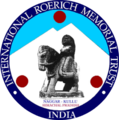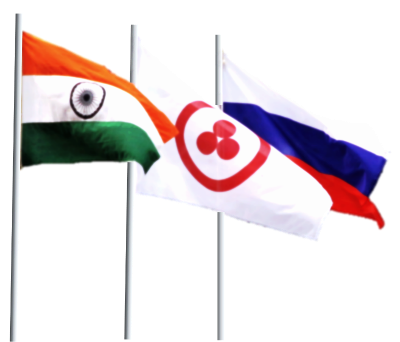18.08.2019
Academic Seminar “George Roerich’s Scientific Research in Himalayas and Tibet” held in the IRMT
A One-day International Academic Seminar on George Roerich’s Scientific Research in Himalayas and Tibet, dedicated to the 117th Anniversary of George Roerich has been conducted on 18th August 2019, at the International Roerich Memorial Trust, Naggar (Kullu). The academic seminar was attended by the guests from India, Russia, Ukraine and Tibet. Unfortunately, due to landslides and flood in the locality some participants could not attend the seminar.
In their welcome address to the participants and guests of the seminar, Mrs. Larisa V. Surgina, an employee of the International Centre of the Roerichs (Moscow) and a Russian Curator, IRMT, and Mr. Ramesh Chander, Indian Curator, IRMT, noted the tremendous contributions of George Roerich in preserving the history, culture and dialects of the Central Asia, Himalayan region and Tibet.
Presiding over the seminar, Tsering Dorje, a renowned Buddhist scholar and expert of the Tibetan language and culture, shared his personal experience of meeting George Roerich and how he and one of his uncles guided him in his studies of the Tibetan dialect of Lahaul. He dwelled in detail on George Roerich’s contribution to Lahaul studies. He said that George also studied Tibetan dialects spoken by the people of upper Bhaga and upper Chandra Rivers valley on the lines of linguistics. It was published in the third volume of the Urusvati journal, and was, in fact, a monograph rather than just a paper. It provides a complete description – phonetics, morphology in a systematic way.
The paper “Yuri Roerich and his contribution to Buddhism” was presented by Harsh Lumba - artist, senior researcher at the Ministry of Culture (Delhi, India). She says “In 1932 Yury (George) Roerich published ’The study of Kalachakra’- an esoteric mystic-philosophical Buddhist treaty related to the questions of serialization of time. Nicholas Roerich writes that the system of Kalachakra was brought to Tibet by the Buddhist scientist Atisha in 1027. It coincided with the time when the chronology in Tibet started to be told by Jupiter, and by a 60-year cycle by the lunar calendar. Many Asian nations, including Mongols and Buryats live by this calendar. This chronology is used due to the assumption of the system Kalachakra in Lamaism. Kala, translated from Sanskrit, means time, and chakra - a circle or a wheel - the wheel of time. Kalachakra is a polysemantic phenomenon. It is both the wheel of time and a many-headed and many-handed God of Time. Having carefully studied Tibetan treatises dedicated to this system which belongs to Tantric mystics, Yury wrote his work. This work of Yury Roerich was printed in the periodical of the Himalayan Research Institute. It is a masterpiece of the Great Russian scientist, which is yet to be appreciated.”
During the discussions, Mr. Rajeshwar Thakur, an independent researcher from Raisan presented a paper titled “George Roerich’s Study of the Tibetan Dialect in Tooh and Khoksar Region of Lahul”. Rajeshwar is the great grandnephew of Thakur Rup Chand from Kolong, Lahaul, who during the expedition was the main assistant of Dr. Walter Koelz, the botanist and biologist from the Michigan University who cooperated with ‘Urusvati’ Institute in the beginning of 1930s. In his paper Mr. Thakur said that Roerich family came to Lahul for the first time in 1929 and founded a research centre at Gungshel near Keylong. During their stay in Lahul, Nicholas Roerich and his son Svetoslav Roerich remain engrossed in painting snowy mountains, landscape, Panoramic views, Gompas, Lamas, while Helena Roerich was busy in writing. George Roerich has been engaged in excavation of buried remains, gathering folk songs, linguistic and cultural studies. He has also collected Medicinal plants in the hills with local Amchis (Tibetan doctors). In Lahul George Roerich used to visit many ancient Tibetan Buddhist gompas (Buddhist temples or monasteries) and their head Lamas to study Buddhism and Tibetan dialects.
Ms. Olga Karaseva, a PhD scholar of JNU and research fellow of ICR, Moscow further added that research done by George Roerich on Central Asian history and the history of nomadic tribes underlining the cultural unity existed on the vast territories of Central Asia can benefit to Eurasian thought as well. Though George Roerich never claimed to be a Eurasianist himself but some of his ideas relate to those of the early Eurasianists. He also considered the steppe belt of Eurasia to be a backbone of Eurasian area, the territory with important historical influences where ideas and cultures used to roam freely for centuries. He in his work about the Animal Style connected South Russian steppes with the territories of Central Asia and, further, Tibet based on the similar elements found in their burials and art.
A writer and researcher from Dharamshala, Mr. Tenzin Tsundue while speaking about “George Roerich’s Tibetan studies and translation works with Gendun Choephel” said that it’s amazing that George Roerich learnt more than 20 languages in one life and it’s all because he got thirst of knowledge and discipline from his parents. He further said that George Roerich and Gendun Chophel born in 1902 and 1903 respectively in two different countries, but both had many similarities. Both are travelled widely and spent their life outside, but remained true patriots. Gendun Chophel and George Roerich worked together on the translation of Blue Annals. Now, for Tibetan community, Blue Annals is an important source on the history of Buddhism spread in the Tibet. Both George Roerich and Gendun Chophel died in a young age but it is almost impossible to appreciate fully their contribution to Buddhist studies and studies of the Tibetan culture and history.
Mrs. Kunga Yangdol, veterinary Stock Assistant, dwelled in detail about the tradition of Buchen of Spiti. She said that the comutiny of Buchen resides in the culturally Tibetan region, Pin Valley of Spiti. Their households possess individual ‘archives’, collections of written story texts and texts of rituals, thangkas and other important details. They are best known for performing the Ceremony of the Breaking of the Stone, a ritual culminating in a rock being smashed on a man's abdomen. Bu-chen (literally great sons) are disciples of the 15th century Tibetan 'Crazy Saint' Thang Thong Gyalpo, who first performed the stone breaking and is popularly credited with founding Ache Lhamo, the 'Tibetan Opera'. Buchen are unique in the Tibetan world, but their theatre is unresearched and their local audience is diminishing. There are only five Buchen masters living in the Pin Valley.
In conclusion, the moderator of the seminar Tsering Dorje and the Russian Curator of the IRMT Larisa Surgina thanked the delegates for presenting such interesting papers and expressed their hope for future cooperation with them. The Russian Curator expressed her special gratitude to Gautam Kashyap, Director of Drona Archery School for providing translation assistance in Russian-Hindi-English languages during the seminar.
The seminar ended in warm informal conversation about a personal revelations and thoughts of the participants about George Roerich’s figure and his contribution to the different spheres of oriental studies. The friendly discussion ended only late in the evening. One can claim with certainty that it became one more step towards the revival of ‘Urusvati’ Institute of Himalayan Studies whose director was George Roerich.











Thus, the zone of influence of the animal style include not only the Central Asia but some territories of Tibet. And of course, he spoke about the cultural unity which existed on the same territories before 10th century AD and which still can be found in the very core of Central Asian cultures. His ideas about one centre from which all the nomadic cultures developed is quite similar to the Eurasianist’s idea of “mestorazvitie” or “development-place” with added cultural dimension.
The youngest, who had only recently attained the status of a full master, was Ghatuk Tsering. He consider that he might be the last of the lineage as fewer and fewer younger people were willing to undergo the rigorous physical and spiritual training necessary to become a Buchen.










